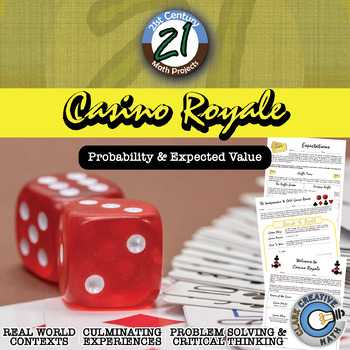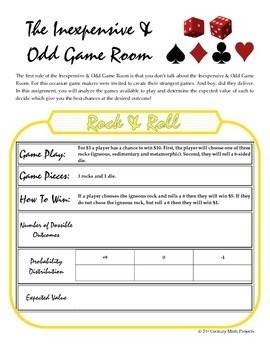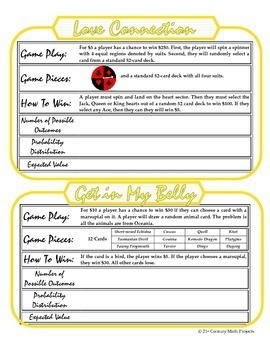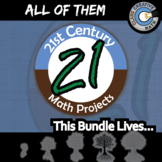Casino Royale -- Expected Value & Probability Game - 21st Century Math Project
- Zip
- Google Apps™

What educators are saying
Also included in
- This is a selection of my Probability & Expected Value resources all in a money saving Essential Bundle! You save significant money and time versus purchasing these separately!Essential Bundles are designed to give you everything you need to rock your unit. Warmups, Notes, Activities, Games, ExiPrice $35.00Original Price $87.00Save $52.00
- The project is the core of what I have built my classroom around. Scaffolding learners to real world projects. This bundle includes the 105+ math projects I have written. This is over 2,700 pages of content.21st Century Math Projects each scaffold through an authentic context and math skill buildingPrice $395.00Original Price $564.00Save $169.00
Learning Objective
Students will practice expected value, probability and compound probability in the authentic context of games. Students conduct an investigation and aim to answer “How does expected value influence carnival and casino games?”
Description
Your students might be begging for for a day for them to play games. Let it be on your terms in this 21st Century Math Project! This Expected Value and Probability Project focuses on one of the more emphasized aspects of the Common Core Standards.
Students will be asked to design their own games with defined expected value and host it in a Game Day event! The student that collects the most "Swagg Cash" will forever (or at least for 36 hours) be known as the Master of Swagg. ***THIS PRODUCT HAS BEEN UPDATED WITH A GOOGLE SLIDES INTERACTIVE VERSION INCLUDED. REDOWNLOAD IF YOU HAVE IT ALREADY***
-- In “Expectations”, students encounter five different situations that involve expected value.
-- In "The Inexpensive and Odd Game Room" student work with five different odd games that include a mix of conditional probability and regular probability.
This of course leads to the final project, "Casino Royale", where students are tasked with being intelligent Game Makers and Game Players.
Download the preview to see it all.
Since this projects is driven by the student's individual choices and some parts will not include an answer key.
You may be interested in the following discounted bundles. SAVE $$$!
•21st Century Math Projects -- All the Projects
Need an Entire Curriculum?
•21st Century Algebra 2 / Pre-Calculus –- the Entire Curriculum
•21st Century Pre-Algebra –- the Entire Curriculum
For more tips, tricks and ideas check out the Clark Creative Education Blog
And join our community where I post ideas, anecdotes, elaborations & every once in a while I pass out TPT gift cards! And jokes! I do jokes too!







